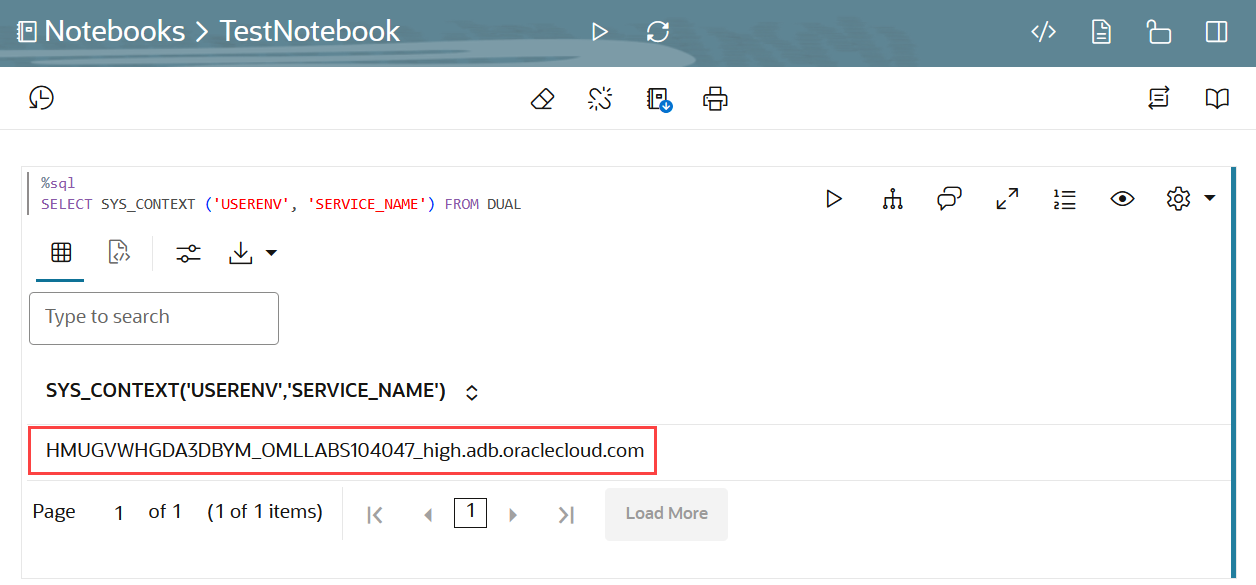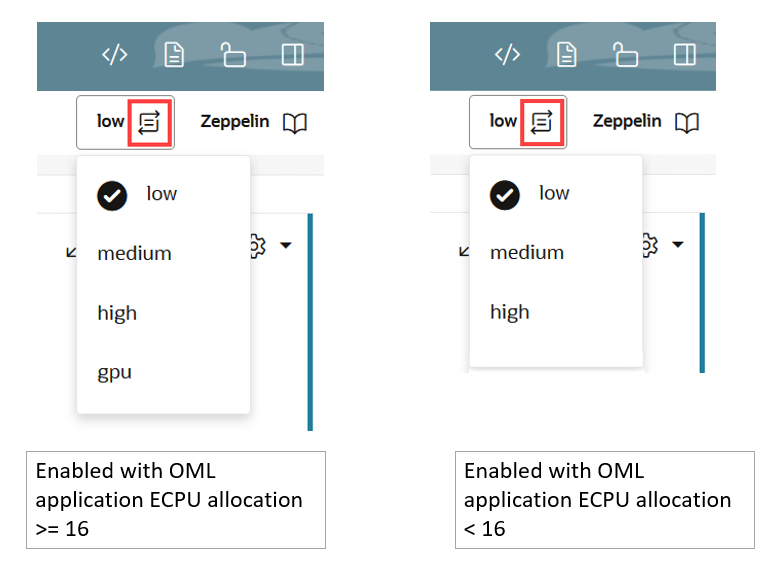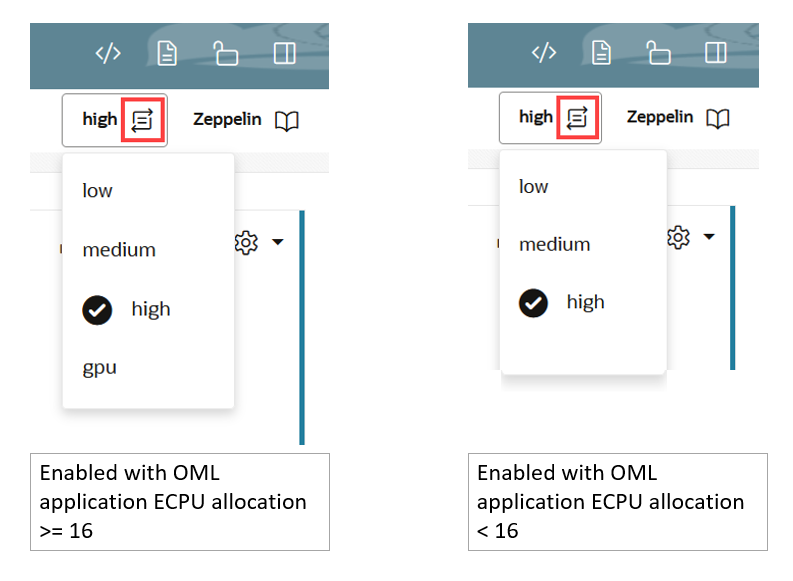4.13 About Interpreters and Notebook Service Levels
An interpreter is a plug-in that allows you to use a specific data processing language backend.
For the Zeppelin Notebooks in Oracle Machine Learning UI, you use the SQL, PL/SQL, Python and R interpreters within an Oracle AI Database interpreter group, and the Markdown interpreter for plain text formatting syntax so that it can be converted to HTML. You use the Conda interpreter to connect to the Conda environment and work with Python third-party library packages.
- SQL—
%sql - PL/SQL—
%script - Python—
%python - R—
%r - Markdown—
%md - Conda—
%conda
- low: Provides the least level of resources for in-database operations, typically serial (non-parallel) execution. It supports the maximum number of concurrent in-database operations by multiple users. The interpreter with low priority is listed at the top of the interpreter list, and hence, is the default.
- medium: Provides a fixed number of CPUs to run in-database operations in parallel, where possible. It supports a limited number of concurrent users, typically 1.25 times the number of CPUs allocated to the pluggable database.
- high: Provides the highest level of CPUs to run in-database operations in parallel, up to the number of CPUs allocated to the pluggable database. It offers the highest performance, but supports the minimum number of concurrent in-database operations, typically 3.
- gpu: Provides GPU compute capabilities in a notebook through the Python interpreter with the database service level set to high. The memory settings is 8 GB (DDR4), by default. It is extensible up to 200 GB.
- Bind and unbind interpreters: If you do not bind any specific interpreter to your notebook, then you get the error message:
Not supported interpreter <name of interpreter>
- Set and re-order interpreter bindings. You may want to set and re-order interpreter bindings if you want to use a specific interpreter for a specific paragraph in a notebook. In that case, you have to select the specific interpreter for that paragraph.
- Change the interpreter binding for any specific paragraph in a notebook
- Notebook creation: When you create a notebook, the notebook inherits the initial interpreter binding order, which is low (default), medium, high.
- Notebook import: When importing a notebook, the notebook inherits the defined interpreter bindings. However, after you import a notebook, ensure to check the order of the interpreter bindings and that the required interpreters are selected.
- Notebook export: When exporting a notebook, the notebook inherits the defined interpreter bindings.
- Notebook creation from templates: When you create a notebook from templates, the notebook inherits the default order of interpreter bindings.
- Change Notebook Service Level
Notebook type corresponds to the ADB service levels — low, medium, high and gpu. These service levels affect parallelism in the database. The notebook type that is set for a notebook applies to all the paragraphs in that notebook. - Verify Notebook Service Level
After changing the Notebook service level, you can use a SQL statement to view and verify the information. Notebook type, referred to as interpreter bindings in Notebooks Classic, corresponds to the ADB service levels — low, medium, high and gpu. These service levels affect parallelism in the database.
Parent topic: OML Notebooks
4.13.1 Change Notebook Service Level
Notebook type corresponds to the ADB service levels — low, medium, high and gpu. These service levels affect parallelism in the database. The notebook type that is set for a notebook applies to all the paragraphs in that notebook.
Note:
In Notebooks Classic, the notebook type is referred to as the interpreter bindings. The notebook type gpu is not available in Notebooks Classic.- SQL —
%sql - PL/SQL —
%script - Python —
%python - R —
%r - Markdown —
%md - Conda —
%conda
Change Notebook Service Levels in the new Notebook
- Open your notebook in the notebook editor.
- Click on the Update Notebook Type icon
on the top right corner. The available notebook types are displayed. The
current notebook type is indicated by a tick mark, and is also displayed
next to the Update Notebook Type icon.
Figure 4-96 ADB service levels as displayed in a notebook
The Notebook Types (ADB service levels) are:- low —Provides the least level of resources for in-database operations, typically serial (non-parallel) execution. It supports the maximum number of concurrent in-database operations by multiple users. The interpreter with low priority is listed at the top of the interpreter list, and hence, is the default.
- medium—Provides a fixed number of CPUs to run in-database operations in parallel, where possible. It supports a limited number of concurrent users, typically 1.25 times the number of CPUs allocated to the pluggable database.
- high—Provides the highest level of CPUs to run in-database operations in parallel, up to the number of CPUs allocated to the pluggable database. It offers the highest performance, but supports the minimum number of concurrent in-database operations, typically 3.
- gpu—Provides GPU compute capabilities in a notebook through the Python interpreter with the database service level set to high. The notebook memory setting is 32 GB (DDR4), by default. It is extensible up to 200 GB.
- To change the notebook type, click on the type that you want to
select. In this example, let's click high. A
confirmation message is displayed stating: Notebook Type is updated
to "high".
Note:
The updated notebook type is applicable to all the paragraphs in the notebook. You cannot change the notebook type at the paragraph level.
Parent topic: About Interpreters and Notebook Service Levels
4.13.2 Verify Notebook Service Level
After changing the Notebook service level, you can use a SQL statement to view and verify the information. Notebook type, referred to as interpreter bindings in Notebooks Classic, corresponds to the ADB service levels — low, medium, high and gpu. These service levels affect parallelism in the database.
Note:
For Python notebooks, do not override the interpreter binding at the paragraph level.Verify Notebook Service Level in a Notebook
- Open the notebook for which you want to verify the updated notebook type.
- Run the following SQL statement:
%sql SELECT SYS_CONTEXT ('USERENV', 'SERVICE_NAME') FROM DUAL; - Click Run. The SQL statement returns the following
information about the updated notebook type, as shown in the screenshot
below:
Figure 4-98 ADB service level information as displayed in a notebook

HMUGVWHGDA3DBYMis the tenant nameOMLLABS104047is the database namehighis the ADB service nameadb.oraclecloud.comis the domain
Verify Interpreter Bindings in Notebooks Classic
- Open the Notebooks Classic for which you want to validate the updated interpreter bindings.
- Run the following SQL statement:
%sql SELECT SYS_CONTEXT ('USERENV', 'SERVICE_NAME') FROM DUAL; - The SQL statement returns the following information about the updated
interpreter bindings, as shown in the screenshot below:
Figure 4-99 ADB service level information as displayed in Notebooks Classic

HMUGVWHGDA3DBYMis the tenant nameOMLLABS104047is the database namehighis the ADB service nameadb.oraclecloud.comis the domain
Parent topic: About Interpreters and Notebook Service Levels

